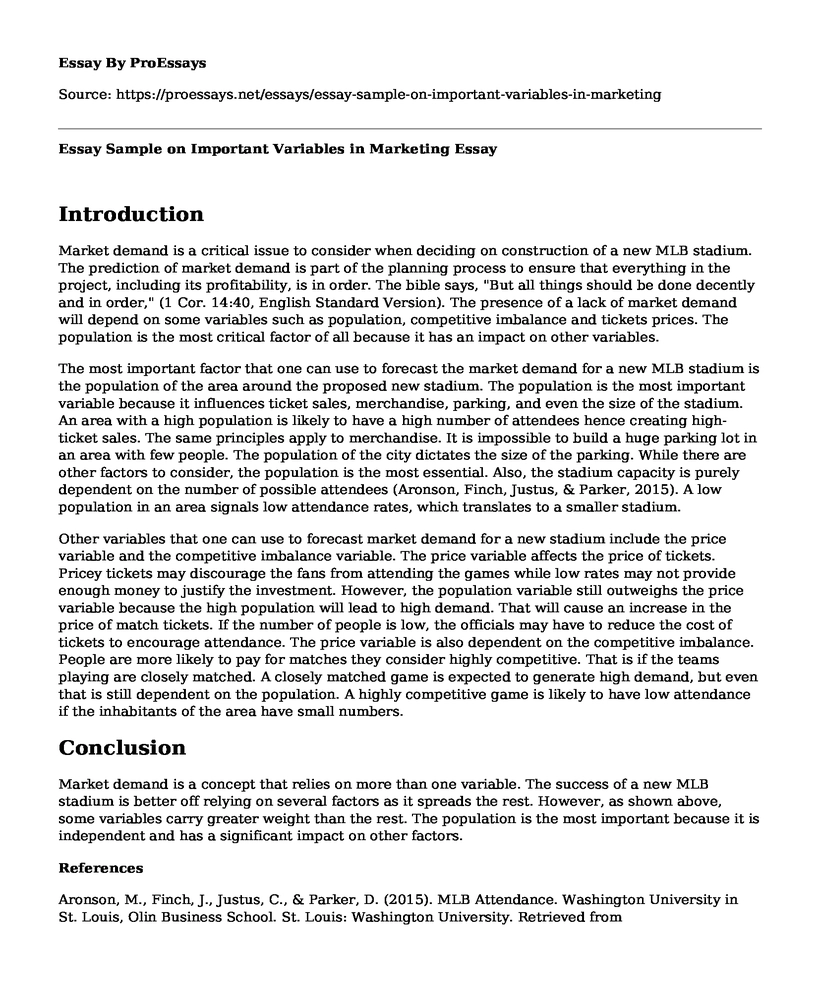Introduction
Market demand is a critical issue to consider when deciding on construction of a new MLB stadium. The prediction of market demand is part of the planning process to ensure that everything in the project, including its profitability, is in order. The bible says, "But all things should be done decently and in order," (1 Cor. 14:40, English Standard Version). The presence of a lack of market demand will depend on some variables such as population, competitive imbalance and tickets prices. The population is the most critical factor of all because it has an impact on other variables.
The most important factor that one can use to forecast the market demand for a new MLB stadium is the population of the area around the proposed new stadium. The population is the most important variable because it influences ticket sales, merchandise, parking, and even the size of the stadium. An area with a high population is likely to have a high number of attendees hence creating high-ticket sales. The same principles apply to merchandise. It is impossible to build a huge parking lot in an area with few people. The population of the city dictates the size of the parking. While there are other factors to consider, the population is the most essential. Also, the stadium capacity is purely dependent on the number of possible attendees (Aronson, Finch, Justus, & Parker, 2015). A low population in an area signals low attendance rates, which translates to a smaller stadium.
Other variables that one can use to forecast market demand for a new stadium include the price variable and the competitive imbalance variable. The price variable affects the price of tickets. Pricey tickets may discourage the fans from attending the games while low rates may not provide enough money to justify the investment. However, the population variable still outweighs the price variable because the high population will lead to high demand. That will cause an increase in the price of match tickets. If the number of people is low, the officials may have to reduce the cost of tickets to encourage attendance. The price variable is also dependent on the competitive imbalance. People are more likely to pay for matches they consider highly competitive. That is if the teams playing are closely matched. A closely matched game is expected to generate high demand, but even that is still dependent on the population. A highly competitive game is likely to have low attendance if the inhabitants of the area have small numbers.
Conclusion
Market demand is a concept that relies on more than one variable. The success of a new MLB stadium is better off relying on several factors as it spreads the rest. However, as shown above, some variables carry greater weight than the rest. The population is the most important because it is independent and has a significant impact on other factors.
References
Aronson, M., Finch, J., Justus, C., & Parker, D. (2015). MLB Attendance. Washington University in St. Louis, Olin Business School. St. Louis: Washington University. Retrieved from http://washusportsanalytics.weebly.com/uploads/5/0/0/9/50097143/final_project_-_group_5_aronson_finch_justus_parker_(1)_(1).pdf
Cite this page
Essay Sample on Important Variables in Marketing. (2022, Nov 22). Retrieved from https://proessays.net/essays/essay-sample-on-important-variables-in-marketing
If you are the original author of this essay and no longer wish to have it published on the ProEssays website, please click below to request its removal:
- The Men vs. Women Challenge Campaign by Nike
- Financial Analysis of IBM
- Michael Porter Diamond Theory Essay
- Rice Supply Chain in China Paper Example
- Essay Sample on Cigarette Companies: Persuasive Ads, Quadrupled Spending
- Paper Example on Internal Alignment: Improving Leadership, Efficiency & Respect
- Paper Sample on Pfizer Ireland: Outsourcing Logistics & Supply Chain Strategies







